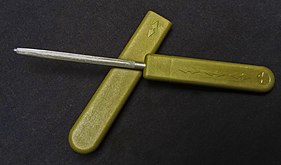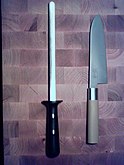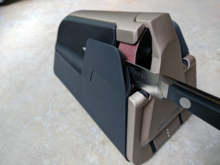Knife sharpener
A knife sharpener , sometimes also called a knife sharpener, is a kitchen appliance used to maintain or restore the sharpness of knives and sometimes scissors and other cutting tools. In addition to household use, they are used in the commercial sector, for example in catering , large kitchens and slaughterhouses . There is a wide range of different types and shapes. The most common are sharpening sticks , whetstones and manual sharpeners . There are also electric sharpeners that came on the market as small appliances for household and commercial use in the second half of the 20th century, as well as some special features.
Background and functionality
With regular use of knives, the blades will become dull over time. The blade edge is - especially with high-quality knives - only a few hundredths of a millimeter thin and bends even with the most careful handling when cutting. The pointed, sharp edge (ridge) of the blade gradually wraps itself around, and when enlarged, the ridge looks more like a fine saw. As a result, the knife becomes blunt and no longer holds the edge.
The cutting edges can be sharpened again using a knife sharpener. While the function is basically the same for every device, the different models differ in the abrasive material. In this case, be diamond , ceramic or steel used. In order for the cutting edges to be sharp, the grinding material must be harder than the material of the knife blade.
Practice is important when sharpening. The German consumer organization Stiftung Warentest gives the following recommendations for the use of knife sharpeners:
For sharpening sticks, the front and back of the blade should be sharpened over the stick at an angle of 20 degrees on knives of European and North American origin. They are also suitable for Japanese knives (types) of European origin, while knives from Asian suppliers are often harder than the sticks and should not be sharpened in order not to damage the sensitive edges. In addition, knives of Japanese origin are usually sharpened at an angle of 15 degrees and some are only sharpened on one side; Sharpening them requires special skills and should ideally be done with wet whetstones and polishing stones. When using whetstones, it usually has to be wet, the blade has to be rubbed slowly and evenly over the stone. When using a manual or electric sharpener, the blade should be pulled through the rollers as evenly as possible so that no notches or grooves are formed.
Knives should always be sharpened directly on the cutting edge, whereby the angle changes over time. The basic grinding is worn out and should be renewed from time to time - depending on the use, for example after three to six months in the professional kitchen, in private households after two to three years - by a specialist such as a professional knife and scissors grinder .
When using sharpening devices, it often depends on the skill of the user how sharp the blade edge actually becomes or whether it is even damaged. If too much material is removed, a “frayed cutting edge” can result from breaking off and ultimately the blade can be ruined. In addition, it is sometimes not easy to "always pull the knife through the rollers evenly and at the right angle".
Types and shapes
There are different types that can be divided into two groups: straightening knife sharpeners , in which "the steel" is only straightened, and cutting knife sharpeners or knife grinders, in which material is removed. There are also knife sharpeners that are designed for different materials such as stainless steel or ceramic . There is also a choice between manual and electric knife sharpeners. There are mostly dual models on the market for coarse and fine grinding, but sometimes there are also models with a third level for a medium degree of grinding or for polishing and sometimes for serrated serrated knives .
However, recommends the Stiftung Warentest, sharpening ceramic knives , as well as bread knives with serrated edge or steak knives better to leave with serrated blade, etc. professionals.
variants
Sharpening steels / sharpening sticks, ceramic sharpening sticks
Sharpening steels are used for dressing and sharpening knives. They are mostly rod-shaped and made of hard steel with a round, oval, square or flat cross-section. They are usually equipped with a handle and finger protection. As cutting steels, which allow a sharpening of the knives due to low material removal, they can be found in most households, as they can be obtained everywhere and also mostly inexpensive. The cutting steels usually have so-called trains in the form of fine longitudinal grooves. Directing sharpening rods or Abziehstähle however, have a polished or microfine surface structure. Such sharpening steels are mainly used in the professional sector (meat processing, gastronomy, etc.) and for high-quality knives. In addition, they are mostly only available from specialist retailers and for butcher shops.
Sharpening steels are sometimes also generally referred to as sharpening sticks , but should not be confused with ceramic sharpening sticks . Such ceramic sharpening rods are similar in structure to conventional steel sharpening rods , but have a round or oval rod made of ceramic or industrial ceramics . They are among the cutting sharpening rods and are harder than the steel bars. Ceramic sharpening sticks are used for dressing and sharpening as well as for quick sharpening of ( kitchen ) knives.
Miniature sharpening steel for outdoor activities
Grindstones
Whetstones are usually elongated, palm-sized to hand-sized stones for sharpening cutting tools (or for shaping precious stones). They are made from different materials. Natural stones are mined all over the world for grinding purposes. For example, the Arkansas stones , Belgian chunks and Japanese water stones named after the respective mining area are known . Artificial stones ( synthetic grindstones ) can consist of various abrasive materials. Round grinding stones for rotating tools such as grinding machines , which are mostly reserved for professional users, are called grinding disks or wheels.
The knives are sharpened back and forth on whetstones. This makes them one of the manual knife sharpeners that only remove a small amount of material. The use of (Japanese) water stones, which are soaked with water and moistened during grinding, is considered a particularly intensive but gentle process. The knife edges are smooth and very sharp. Combination stones have two different grain sizes, while so-called sharpening stones are used for fine grinding. According to Stiftung Warentest, " real Japanese knives [...] wet grinding is compulsory, for European knives the gentlest kind". However, working with it requires patience and practice - grinding on wet stone has to be done regularly, takes a lot of time and has “a kind of meditative character”. The stones are fragile and should not fall off.
Manual sharpeners
Manual sharpeners are easy to use and require little practice. They are often suitable for different blades and sometimes also for scissors. Depending on the manufacturer, model and abrasive material used, some of them are expensive; Cheap products can damage the blades.
They have V-shaped interlaced grinding inserts or are designed with grinding rollers or discs. Mostly they have guide rails for easier handling. In higher-quality devices there are several guide rails, so that rough sanding, fine sanding and sometimes also polishing can be carried out. Manual sharpeners do not simply straighten the burr, they remove material, as can often be seen from the fine metal chips that remain.
Manual outdoor knife sharpener from Victorinox , with tungsten carbide inserts
Simple manual sharpening device, with steel washers
Manual sharpening device with three sharpening stages, with diamond grinding tools
Electric sharpeners
Electric sharpeners have the same or higher scope of performance than manual knife sharpeners and offer greater convenience: Here, only the knife has to be placed in the guide rail and the electrically driven device takes over the grinding movements that would otherwise have to be carried out by hand. They usually have two or three guide rails (coarse and fine sanding, polishing). In addition, they are often suitable for different types of knives and sometimes also for serrated knives.
Electric sharpening devices that work with belt grinders are to be classified as professional devices. They are, among others, professional knife-grinders and sharpening services as well as knife makers used and require a lot of exercise. A US manufacturer offers belt sanders in miniature format, in which sanding belts with different grain sizes can be used and the desired sanding angle can be maintained automatically using the appropriate adapter.
Electric sharpener with two grinding stages, with grinding tools made of " Sapphirite "
Electric sharpener with three sharpening levels, with diamond grinding tools
Electric sharpener with automated grinding program, with ceramic grinding tools
Features and related sharpening tools
Special designs of commercially available knife sharpeners include:
- Sharpening bench - knife sharpener made of unglazed porcelain in the form of a "bench" over which the knives are drawn
- Sharpening hat - cone-shaped knife sharpener made of unglazed porcelain, on which the knives are drawn vertically
In addition, individual products are offered by various manufacturers, which are mostly marketed as "patent solutions" and the like, such as:
- Knife sharpening set with clamping system - both the knife and a special whetstone of different grit sizes are used in a clamp holder which, with the help of a guide rod, is intended to ensure an even sharpening angle
- Roller grinder - The knife, which is fixed in a grinding gauge, is sharpened by rolling along an exposed roller with two different coarsely coated grinding wheels on both sides of the cutting bevels
Related sharpening tools include:
literature
- Josh Donald: Sharp. The Definitive Introduction to Knives, Sharpening, and Cutting Techniques, with Recipes from Great Chefs. Abrams & Chronicle Books, London 2018, ISBN 978-1452163062 (English).
- Marius, Mélanie Martin: knife. Recipes and Techniques. Callwey, Munich 2017, ISBN 978-3-7667-2282-9 .
Web links
Individual evidence
Note: Individual references given at the end of paragraphs refer to the entire paragraph before.
- ↑ a b c d e f g h i j k l m n knife sharpener. Sharpening steel sharpens best . In: Stiftung Warentest (Ed.): Test . No. 01/2010 , p. 64–69 ( test.de [accessed March 11, 2020]).
- ↑ a b c d e f g h i j The best 13 knife sharpeners for all-round sharp knives in comparison - 2020 test and guide. In: stern.de . 2020, accessed on March 11, 2020 (comparison and consumer portal on stern.de, based on information from Heidorn GmbH , Breitenworbis).
- ↑ See e.g. B .: Christian Wietschorke: How often do you sharpen knives? Tips from the professional! In: messerundscherenschleifer.de. Retrieved March 11, 2020 .














